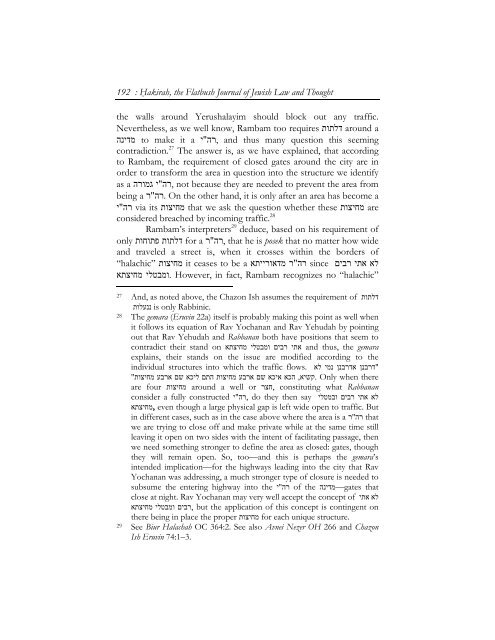King Solomon's Takanah: Rambam's Eruv - Hakirah.org
King Solomon's Takanah: Rambam's Eruv - Hakirah.org
King Solomon's Takanah: Rambam's Eruv - Hakirah.org
Create successful ePaper yourself
Turn your PDF publications into a flip-book with our unique Google optimized e-Paper software.
192 : Hạkirah, the Flatbush Journal of Jewish Law and Thought<br />
the walls around Yerushalayim should block out any traffic.<br />
Nevertheless, as we well know, Rambam too requires דלתות around a<br />
"י to make it a מדינה<br />
, and thus many question this seeming contradiction. 27 The answer is, as we have explained, that according<br />
to Rambam, the requirement of closed gates around the city are in<br />
order to transform the area in question into the structure we identify<br />
as a " , not because they are needed to prevent the area from<br />
being a "ר . On the other hand, it is only after an area has become a<br />
"י<br />
are מחיצות that we ask the question whether these מחיצות via its considered breached by incoming traffic. 28<br />
Rambam’s interpreters 29 deduce, based on his requirement of<br />
only פתוחות for a "ר ,רה that he is posek that no matter how wide<br />
and traveled a street is, when it crosses within the borders of<br />
“halachic” מחיצות it ceases to be a<br />
“halachic” However, in fact, Rambam recognizes no .ומבטלי מחיצתא<br />
לא אתי רבים since רה "ר מדאורייתא<br />
רה<br />
רה י גמורה<br />
רה<br />
רה<br />
דלתות<br />
דלתות 27 And, as noted above, the Chazon Ish assumes the requirement of<br />
Rabbinic. is only ננעלות<br />
28 The gemara (<strong>Eruv</strong>in 22a) itself is probably making this point as well when<br />
it follows its equation of Rav Yochanan and Rav Yehudah by pointing<br />
out that Rav Yehudah and Rabbanan both have positions that seem to<br />
contradict their stand on אתי רבים ומבטלי מחיצתא and thus, the gemara<br />
explains, their stands on the issue are modified according to the<br />
individual structures into which the traffic flows. "<br />
" . Only when there<br />
are four מחיצות around a well or ,חצר constituting what Rabbanan<br />
לא אתי רבים ובמטלי do they then say ,רה "י consider a fully constructed<br />
even though a large physical gap is left wide open to traffic. But ,מחיצתא<br />
רה<br />
דרבנן אדרבנן נמי לא<br />
קשיא, הכא איכא שם ארבע מחיצות התם ליכא שם ארבע מחיצות<br />
in different cases, such as in the case above where the area is a "ר that<br />
we are trying to close off and make private while at the same time still<br />
leaving it open on two sides with the intent of facilitating passage, then<br />
we need something stronger to define the area as closed: gates, though<br />
they will remain open. So, too—and this is perhaps the gemara’s<br />
intended implication—for the highways leading into the city that Rav<br />
Yochanan was addressing, a much stronger type of closure is needed to<br />
subsume the entering highway into the רה "י of the gates—מדינה that<br />
לא אתי close at night. Rav Yochanan may very well accept the concept of<br />
, but the application of this concept is contingent on<br />
there being in place the proper מחיצות for each unique structure.<br />
29 See Biur Halachah OC 364:2. See also Avnei Nezer OH 266 and Chazon<br />
Ish <strong>Eruv</strong>in 74:1–3.<br />
רבים ומבטלי מחיצתא
















